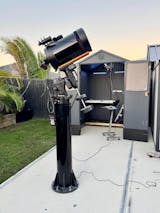TESTAR PIER 2000
TESTAR PIER 2000 - 700mm is backordered and will ship as soon as it is back in stock.
The Testar Pier 2000 is an extremely sturdy steel pier for observatories. Testar Piers are engineered in-house by us based on the original design by 10 Micron and using FEM analysis to ensure structural superiority compared to other piers on the market.
The thick steel construction, dip galvanization and powder coating make it virtually indestructible, with a base thickness of 25mm and tube thickness of 8.2mm. The structural fins on the base are engineered to reduce low frequency vibration and avoid resonance effects caused by wind.
The Testar Pier 2000 is available in four different heights: 700mm, 900mm,1200mm and 1500mm. It is natively compatible with the 10 Micron GM1000(with adapter), GM2000 (with adapter), Avalon Linear & M-Uno, and iOptron CEM120 (with adapter). More adapters are in development. We can custom manufacture an adapter to suit other mounts if required.
The pier has two threaded holes on the side that allow to connect the 10Micron control box holder. For the correct orientation of the pier, see the image below:
Note: the Testar Pier 3000 is pictured here. The Pier 2000 is not as wide.
The supplied installation kit includes galvanized Ramset Chemset CS16190GH M16 x 190mm anchor studs, air pump and brush for cleaning the holes, and driver bit for the studs.
You will need to supply hammer drill with 18mm SDS bit, to screw in the studs and epoxy vials for anchoring the studs. We recommend Chemset Maxima Spin Capsules for M16 studs.
A note on levelling the pier:
You may have seen pictures of piers which have three or four bolts between the pier and the telescope mount for "levelling". This is a terrible idea! Piers do not need to be levelled; they simply need to be aligned north-south. Have you ever seen a professional observatory telescope resting on those tiny bolts? Nope.
Not only do such bolts weaken stability and amplify vibrations, but they make the strength of the pier completely pointless. All you need to do to level the mount is align the mount's polar axis with the earth's axis. If the base is not level, it does not matter.
If the pier is not aligned in the north-south plane, you can easily overcome this by adjusting the latitude adjustment of the mount. If the pier is not levelled in the east-west plane, you can compensate for that by adjusting the azimuth and again the latitude slightly.
Specifications
| Material |
Steel, galvanized and powder coated |
|---|---|
| Compatible mounts |
See diagram |
| Base diameter |
390 mm |
| Top diameter | 230 mm |
| Base hole distance | 175 mm from centre |
| Base thickness |
25 mm |
| Tube thickness | 8.2 mm |
| Weight | 700mm - 61kg, 900mm - 70kg, 1200mm - 82kg, 1500mm - 95kg |
| Required hole depth in cement | 125 mm |
| Required cement thickness | 150 mm minimum |

Installation notes
The pier must be installed on a concrete base at least 150mm thick. The holes in the base plate are large enough to allow you to drill through them. The depth of the holes must be 125mm in the concrete. The pier must be aligned on the north-south plane.
Click here for a link to the specifications of the Ramset Chemset anchors.
Video showing installation using Chemset epoxy anchors.







